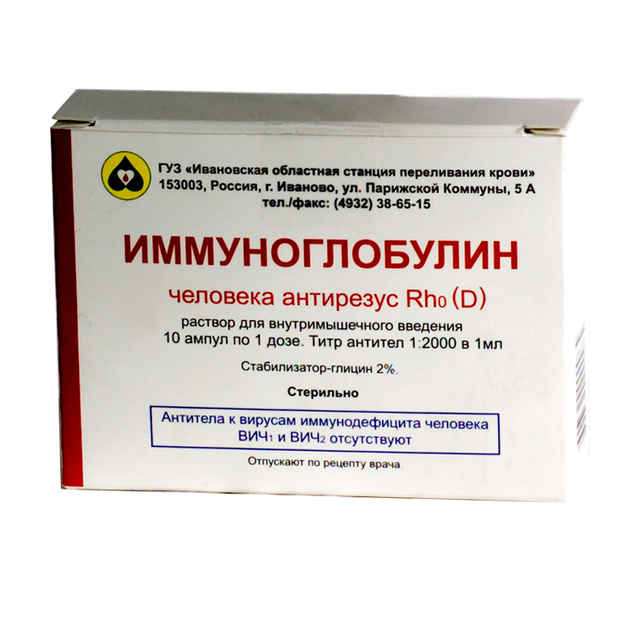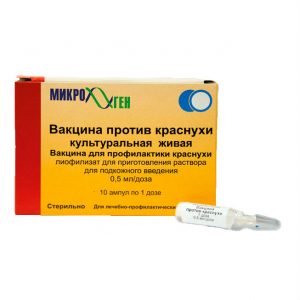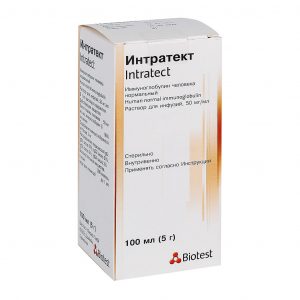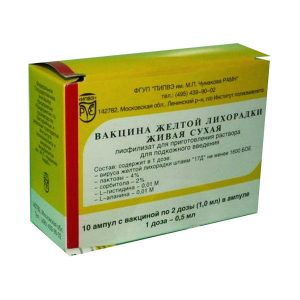Description
Release form
Intramuscular solution
Pharmacological action
Immunoglobulin anti-Rhesus Rh0 D human is an immunologically active protein fraction isolated from human plasma or serum from donors, tested for the absence of antibodies to human immunodeficiency virus (HIV-1, HIV-2), hepatitis C virus and hepatitis B surface antigen B.
The active component of the drug is immunoglobulin G, which contains incomplete anti-Rh0 (D) antibodies. Prevents isoimmunization in a Rh-negative body of a woman exposed to Rh-positive blood as a result of fetal blood entering the mother s bloodstream at the birth of a Rh-positive baby, abortion (both spontaneous and artificial), in case of amniocentesis or in case of trauma to abdominal organs cavities during pregnancy.
When a human immunoglobulin is administered, the Rh0 (D) anti-Rhesus virus within 72 hours after giving birth to a fully-born Rh0 (D) -positive baby with an Rh0 (D) -negative mother decreases the frequency of Rh isoimmunization.
Pharmacokinetics
Absorption. Cmax of antibodies in the blood is reached after 24 hours.
Excretion. T1 / 2 of antibodies from the body is 4 5 weeks.
Contraindications
hypersensitivity to
rhesus-positive puerperas
rhesus-negative puerperas sensitized to Rh0 (D) antigen (in the blood serum of which Rh antibodies were detected).
It is forbidden to administer the drug to newborns.
Special instructions
In children born to women who received human immunoglobulin anti-Rhesus Rh0 (D) before birth, at birth, it is possible to obtain weakly positive results of direct tests for the presence of antiglobulin. In the mother’s blood serum, it is possible to detect antibodies to Rh0 (D) obtained by the passive method if antibody screening tests are performed after the prenatal or postnatal administration of the human immunoglobulin to Rh0 (D).
Immunization of women with live vaccines should be carried out no earlier than 3 months after drug administration.
Due to the possibility of developing allergic reactions, patients should be monitored for 30 minutes after administration of the drug. In the room where the drug is administered, there should be anti-shock therapy. With the development of anaphylactic reactions, antihistamines, glucocorticoids and alpha-adrenomimetics are used.
Therapy with HyperROU C / D may be combined with other drugs, in particular with antibiotics.
The drug is not suitable for use in syringes with impaired integrity or labeling, with a change in physical properties (color, turbidity of the solution, the presence of unbreakable flakes), expired Expiration, improper storage.
Transportation is carried out by any type of indoor transport at a temperature of 2 to 8 ° C.
Dosage and Administration
Intramuscularly. 1 dose (1,500 IU) or 2 doses (3,000 IU) once: to the puerperan – within 72 hours after delivery, if the pregnancy is terminated – immediately after the operation.
The following criteria must be observed: the mother should be Rh-negative and should not already be sensitized to the factor Rh0 (D)
her baby should be Rh-positive.
If the drug is administered before birth, it is important that the mother receives another 1 dose of the drug after the birth of a Rh-positive baby within 72 hours after delivery. If it is established that the father is Rh-negative, there is no need to administer the drug.
Before administration, syringes with the preparation are kept for 2 hours at room temperature (20 ± 2 ° C). In order to avoid the formation of foam, the drug is drawn into a syringe with a wide-lumen needle.
The drug can not be administered intravenously!
For prophylaxis in the postpartum period, 1 dose (1500 IU) of HyperROU C / D should be administered during the first 72 hours after delivery. The need for a certain dose in the case of the passage of the full gestation period varies depending on the amount of fetal blood that has entered the mother ² ¢s bloodstream. 1 dose (1500 IU) contains a sufficient amount of antibodies to prevent sensitization to the Rh factor if the volume of fetal red blood cells that enter the bloodstream does not exceed 15 ml. In cases where it is assumed that a larger volume of red blood cells of the fetus enters the bloodstream of the mother (more than 30 ml of whole blood or more than 15 ml of red blood cells), fetal red blood cell counts should be performed using an approved laboratory procedure (for example, the Kleichauer and Betka modified acid wash-stain method) to establish the required dose of the drug. The calculated volume of fetal red blood cells that enter the bloodstream of the mother is divided into 15 ml and the number of doses of the HyperROU C / D preparation to be administered is obtained. If it is assumed that more than 15 ml of fetal red blood cells are present or a fractional number is obtained as a result of the dose calculation, round up the number of doses to the next whole number in the direction of increase, for example, when receiving a result of 1.4, 2 doses (3000 IU) of the drug should be administered.
For prophylaxis in the prenatal period, 1 dose of the drug (1500 IU) should be administered at approximately the 28th week of pregnancy. Then you must definitely introduce another 1 dose (1500ME), preferably within 72 hours after birth if the baby is Rh-positive.
In the case of continued pregnancy after the threat of abortion occurs at any stage of pregnancy, 1 dose (1500 IU) of the drug should be administered. If it is suspected that more than 15 ml of fetal red blood cells enter the mother ² ¢s bloodstream, it is necessary to change the dose (as indicated above).
After a spontaneous abortion, artificial abortion, or abortion with a gestational age of more than 13 weeks, 1 dose (1500 IU) of the drug is recommended. If it is suspected that more than 15 ml of fetal red blood cells enter the mother ² ¢s bloodstream, it is necessary to change the dose (as indicated above). If the pregnancy is terminated for less than 13 weeks, a single dose of a mini-dose of HyperROU C / D (approximately 250 IU) is possible.
After amniocentesis at the 15 ² 18th week of pregnancy or during the third trimester of pregnancy, or when an abdominal organ injury occurs during the second and / or third trimester of pregnancy, 1 dose (1500 IU) of the drug should be administered. If it is suspected that more than 15 ml of red blood cells enter the bloodstream of the mother, it is necessary to change the dose as described above. If an abdominal injury, amniocentesis, or other adverse circumstance requires the administration of the drug for a period of 13 ² 18 weeks of pregnancy, another 1 dose (1500 IU) should be administered for a period of 26 ² 28 weeks.
To maintain protection throughout pregnancy, the concentration of passively obtained antibodies to Rh0 (D) should not be allowed to fall below the level necessary to prevent an immune response to Rh-positive red blood cells. T1 / 2 of human immunoglobulin Rh0 (D) anti-Rhesus is 23 ² 26 days. In any case, the dose should be administered within 72 hours after birth if the baby is Rh-positive. If childbirth occurs within 3 weeks after receiving the last dose, the postpartum dose can be canceled (except in cases where more than 15 ml of fetal red blood cells have entered the bloodstream of the mother).
Side effects
Possible: hyperemia, fever up to 37.5 ° (during the first days after administration), dyspeptic symptoms.
In some cases, patients with altered reactivity (including immunoglobulin A deficiency) may develop allergic reactions of various types (including anaphylactic shock).
Storage conditions
In a dark place at a temperature of 2 8 ° C.
Shelf life
3 years
active substance
Immunoglobulin Human antirezus Rho (D)
Conditions of release from
pharmacies Prescription
lekarstvennaja form
Solution for




